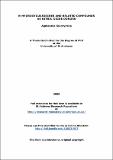Files in this item
N-hydroxyguanidines and related compounds as nitric oxide donors
Item metadata
| dc.contributor.advisor | Botting, Nigel P. | |
| dc.contributor.author | Kulczynska, Agnieszka | |
| dc.coverage.spatial | [xi], 310 | en_US |
| dc.date.accessioned | 2010-07-02T11:39:43Z | |
| dc.date.available | 2010-07-02T11:39:43Z | |
| dc.date.issued | 2009 | |
| dc.identifier | uk.bl.ethos.552344 | |
| dc.identifier.uri | https://hdl.handle.net/10023/957 | |
| dc.description.abstract | The design of new, improved NO-donor drugs is an important pharmacological objective due to the biological importance of nitric oxide. N-Hydroxyguanidines represent a useful class of NO donors where the mechanism of action is based on the biosynthetic pathway for NO. Thirty new N-arylalkyl-N’-hydroxyguanidines were synthesized and their vasodilatation activity examined by myography in rat aortic rings. The observed relaxations were reversed by ODQ, which is an inhibitor of the guanylate cyclase, implying that this was an NO dependent vasodilatation. The most active compounds were also tested in the isolated perfused kidney (IPK) giving the vasodilatation properties. Preliminary results indicated that N-phenyl-N’- hydroxyguanidine showed the best pharmacological profile with EC₅₀= 19.9 μM and ca. 100% reversibility with ODQ. A series of N-phenylalkyl-N’-hydroxyguanidines were synthesised. NO donor activity was found to be fairly constant up to three methylene groups, and then decreased. Substitutions in the benzene ring of N-phenylethyl-N’-hydroxyguanidine demonstrated that various electron-withdrawing and electron-donating groups in the para position did not significantly affect the NO donor activity of this series of analogues. The nitro and trifluoromethyl substituted compounds gave the best biological profiles. Additionally, a novel heterocyclic, N–furfuryl-N’–hydroxyguanidine possessed very promising vasodilatation properties. In general, almost all the N-arylalkyl-N’-hydroxyguanidines behaved as potent NO donors in the rat aorta assay. In order to establish the influence of the free NH₂ group in the hydroxyguanidine functionality on the vasodilatation properties, N,N-dimethyl and N-methyl-N’- hydroxyguanidines were successfully synthesised. Unfortunately, they have not been tested yet in the biological assay. However, their NMR spectra showed some unusual features and their detailed analysis and X-ray data are presented herein. In addition a series of hydroxamic acids was synthesised and the NO donor activity investigated using the same biological methodology. It was found that the 3-phenylpropionohydroxamic acid was the most potent compound with EC₅₀ = 6 μM and ODQ = 96%. However, behavior in the IPK indicated that hydroxamic acids did not undergo the same biological pathway as in the rat aorta. Two different types of enzyme-activated pro-drugs were designed using N-hydroxyguanidines as the NO donating molecule. Synthetic studies towards these targets were carried out using various synthetic approaches. The desired molecules have not yet been synthesised but the chemistry explored so far has indicated potentially more successful approaches that could be attempted. | en_US |
| dc.language.iso | en | en_US |
| dc.publisher | University of St Andrews | |
| dc.subject.lcc | QP535.N1K8 | |
| dc.subject.lcsh | Nitric oxide | en_US |
| dc.subject.lcsh | Nitric oxide | en_US |
| dc.subject.lcsh | Biosynthesis | en_US |
| dc.subject.lcsh | Guanidines | en_US |
| dc.subject.lcsh | Pharmaceutical chemistry | en_US |
| dc.subject.lcsh | Vasodilators | en_US |
| dc.title | N-hydroxyguanidines and related compounds as nitric oxide donors | en_US |
| dc.type | Thesis | en_US |
| dc.type.qualificationlevel | Doctoral | en_US |
| dc.type.qualificationname | PhD Doctor of Philosophy | en_US |
| dc.publisher.institution | The University of St Andrews | en_US |
This item appears in the following Collection(s)
Items in the St Andrews Research Repository are protected by copyright, with all rights reserved, unless otherwise indicated.

